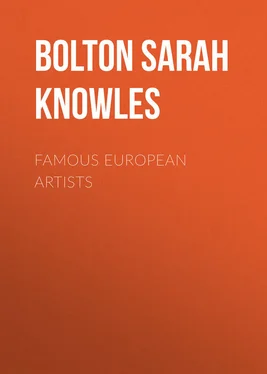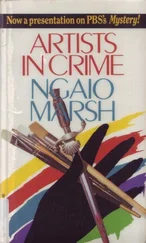Sarah Bolton - Famous European Artists
Здесь есть возможность читать онлайн «Sarah Bolton - Famous European Artists» — ознакомительный отрывок электронной книги совершенно бесплатно, а после прочтения отрывка купить полную версию. В некоторых случаях можно слушать аудио, скачать через торрент в формате fb2 и присутствует краткое содержание. ISBN: , Жанр: foreign_prose, foreign_antique, foreign_language, на английском языке. Описание произведения, (предисловие) а так же отзывы посетителей доступны на портале библиотеки ЛибКат.
- Название:Famous European Artists
- Автор:
- Жанр:
- Год:неизвестен
- ISBN:http://www.gutenberg.org/ebooks/39380
- Рейтинг книги:5 / 5. Голосов: 1
-
Избранное:Добавить в избранное
- Отзывы:
-
Ваша оценка:
- 100
- 1
- 2
- 3
- 4
- 5
Famous European Artists: краткое содержание, описание и аннотация
Предлагаем к чтению аннотацию, описание, краткое содержание или предисловие (зависит от того, что написал сам автор книги «Famous European Artists»). Если вы не нашли необходимую информацию о книге — напишите в комментариях, мы постараемся отыскать её.
Famous European Artists — читать онлайн ознакомительный отрывок
Ниже представлен текст книги, разбитый по страницам. Система сохранения места последней прочитанной страницы, позволяет с удобством читать онлайн бесплатно книгу «Famous European Artists», без необходимости каждый раз заново искать на чём Вы остановились. Поставьте закладку, и сможете в любой момент перейти на страницу, на которой закончили чтение.
Интервал:
Закладка:
In early life he had been so devoted to science that Vasari tells us "by this means he conceived such heretical ideas that he did not belong to any religion, but esteemed it better to be a philosopher than a Christian." Now he turned his thoughts toward the Catholic church, and made his will, which recommends his soul "to God, the glorious Virgin Mary, his lordship St. Michael, and all the beautiful angels and saints of Paradise." He wishes that at his obsequies "there shall be sixty torches carried by sixty poor persons, who shall be paid for carrying them according to the discretion of the said Melzi, which torches shall be shared among the four churches above named."
To his beloved pupils, ever with him, he gives his property. Nine days after this, says Vasari, May 2, 1519, at the age of sixty-seven, Leonardo died in the arms of his devoted King, Francis I.; but later historians have considered this doubtful. He was buried under the flag-stones in the Church of St. Florentin at Amboise.
In the religious wars which followed, the church was demolished, the gravestones sold, and the lead coffins melted for their metal. Many persons have tried to find the grave of the great master, and M. Arsène Houssaye made a last and perhaps successful attempt in 1863. He says, "More than one Italian had gone to Amboise for the purpose of finding the tomb of Leonardo da Vinci, and had gazed sadly on the spot where the church once stood, now covered by thick growing covert.
"The gardener's daughter had been often questioned, and it was she who first gave me the idea, some years ago, of seeking for the tomb of the painter of the 'Last Supper,' but I do not know whether the fact of her having the painter's name sometimes on her lips arose from the fact of her hearing him spoken of by her father or by visitors. She it was who pointed out to me the spot where the great painter of Francis I. might be found; a white-cherry tree was growing there, whose fruit was so rich from the fact of its growing above the dead.
"On Tuesday, the 23d of June, 1863, the first spadeful of earth was turned up before the mayor and the archbishop of Amboise. I set the men to work on three different spots, some to reconnoitre the foundations of the church, others to look for the ossuary, and the rest to search the tombs. It was necessary to dig down deeply, the soil having risen over the site of the church to the height of two or three yards…
"The 20th of August we lighted on a very old tomb, which had been, at the demolition of St. Florentin, covered with unequal stones. No doubt the original tombstone had been broken, and, out of respect for the dead, replaced by slabs belonging to the church, and bearing still some rude traces of fresco painting… It was in the choir of the church, close to the wall, and toward the top of the plantation, where grew the white-cherry tree.
"We uncovered the skeleton with great respect; nothing had occurred to disturb the repose of death, excepting that towards the head the roots of the tree had overturned the vase of charcoal. After displacing a few handfuls of earth, we saw great dignity in the attitude of the majestic dead… The head rested on the hand as if in sleep. This is the only skeleton we discovered in this position, which is never given to the dead, and appears that of a deep thinker tired with study… I had brought with me from Milan a portrait of Leonardo da Vinci … and the skull we had taken from its tomb corresponded exactly with the drawing. Many doctors have seen it, and consider it to be the skull of a septuagenarian. Eight teeth still remain in the jaws, four above and four below… The brow projects over the eyes, and is broad and high; the occipital arch was ample and purely defined. Intellect had reigned there, but no especial quality predominated.
"We collected near the head some fragments of hair or beard, and a few shreds of brown woollen material. On the feet were found some pieces of sandals, still keeping the shape of the feet…
"The skeleton, which measured five feet eight inches, accords with the height of Leonardo da Vinci. The skull might have served for the model of the portrait Leonardo drew of himself in red chalk a few years before his death. M. Robert Fleury, head master of the Fine Art School of Rome, has handled the skull with respect, and recognized in it the grand and simple outline of this human yet divine head, which once held a world within its limits."
In 1873 Italy raised a monument to her great genius, at Milan. His statue stands on a lofty pedestal, which has four bas-reliefs, representing scenes from his life. At the four corners are placed statues of his principal scholars, – Cesare da Sesto, Marco d' Oggione, Beltraffio, and Andrea Solario.
All Leonardo's precious manuscripts were bequeathed to Francesco Melzi, and unfortunately became scattered. About the end of the seventeenth century they were mostly in the Ambrosian Library at Milan; but the French under Napoleon took fourteen of the principal manuscripts, leaving only two, which now form the "Codex Atlantico" at Milan. The latter is a collection of four hundred of Leonardo's drawings and manuscripts. One volume on mathematics and physics is among the Arundel Manuscripts, at the British Museum. At Holkham is a manuscript of the Libro Originali di Natura .
In 1651 Raphael Trichet Dupresne, of Paris, published a selection from Da Vinci's works on painting, the Trattato della Pittura , which has been reprinted twenty-two times in six different languages, "one of the best guides and counsellors of the painter." A "Treatise on the Motion and Power of Water" was published later. In 1883 Jean Paul Richter, Knight of the Bavarian Order of St. Michael, after years of labor over the strange handwriting of Da Vinci, from right to left across the page, published much of the work of the great painter, reproducing his sketches by photogravure. He had access to the manuscripts in the Royal Library at Windsor, the Institute of France, the Ambrosian Library at Milan, the Louvre, the Academy of Venice, the Uffizi, the Royal Library of Turin, the British and South Kensington Museums, and Christ Church College, Oxford.
Richter says, "Da Vinci has been unjustly accused of having squandered his powers by beginning a variety of studies, and then, having hardly begun, thrown them aside. The truth is that the labors of three centuries have hardly sufficed for the elucidation of some of the problems which occupied his mighty mind."
Leonardo's astronomical speculations, his remarks on fossils, at that time believed to be mere freaks of nature, his close study of botany, his researches in chemistry, color, heat, light, mechanics, anatomy, music, acoustics, and magnetism, have been an astonishment to every reader.
Among his inventions were "a proportional compass, a lathe for turning ovals, an hygrometer; an ingenious surgical probe, a universal joint, dredging machines, wheelbarrows, diving-suits, a porphyry color-grinder, boats moved by paddle-wheels, a roasting-jack worked by hot air, a three-legged sketching-stool which folded up, a revolving cowl for chimneys, ribbon-looms, coining presses, saws for stone, silk spindles and throwers, wire-drawing and file-cutting, and plate-rolling machines." No wonder he was called the "all-knowing Leonardo."
All his work as a poet is lost, save one sonnet: —
"Who cannot do as he desires, must do
What lies within his power. Folly it is
To wish what cannot be. The wise man holds
That from such wishing he must free himself.
Our joy and grief consist alike in this:
In knowing what to will and what to do;
But only he whose judgment never strays
Beyond the threshold of the right learns this.
Nor is it always good to have one's wish;
What seemeth sweet full oft to bitter turns.
My tears have flown at having my desire.
Therefore, O reader of these lines, if thou
Wouldest be good, and be to others dear,
Will always to be able to do right."
Интервал:
Закладка:
Похожие книги на «Famous European Artists»
Представляем Вашему вниманию похожие книги на «Famous European Artists» списком для выбора. Мы отобрали схожую по названию и смыслу литературу в надежде предоставить читателям больше вариантов отыскать новые, интересные, ещё непрочитанные произведения.
Обсуждение, отзывы о книге «Famous European Artists» и просто собственные мнения читателей. Оставьте ваши комментарии, напишите, что Вы думаете о произведении, его смысле или главных героях. Укажите что конкретно понравилось, а что нет, и почему Вы так считаете.












